Case Study on Nursing Assessment
VerifiedAdded on 2023/06/08
|12
|3362
|429
AI Summary
This case study discusses the nursing assessment of an 83-year-old patient with a history of hypertension and osteoporosis. It covers GPN health assessments, activities of daily living, and nursing care recommendations. The patient experienced a fracture in the left neck of the femur and required assistance with daily activities. The nurse recommended various measures to improve the patient's quality of life and ensure proper recovery.
Contribute Materials
Your contribution can guide someone’s learning journey. Share your
documents today.
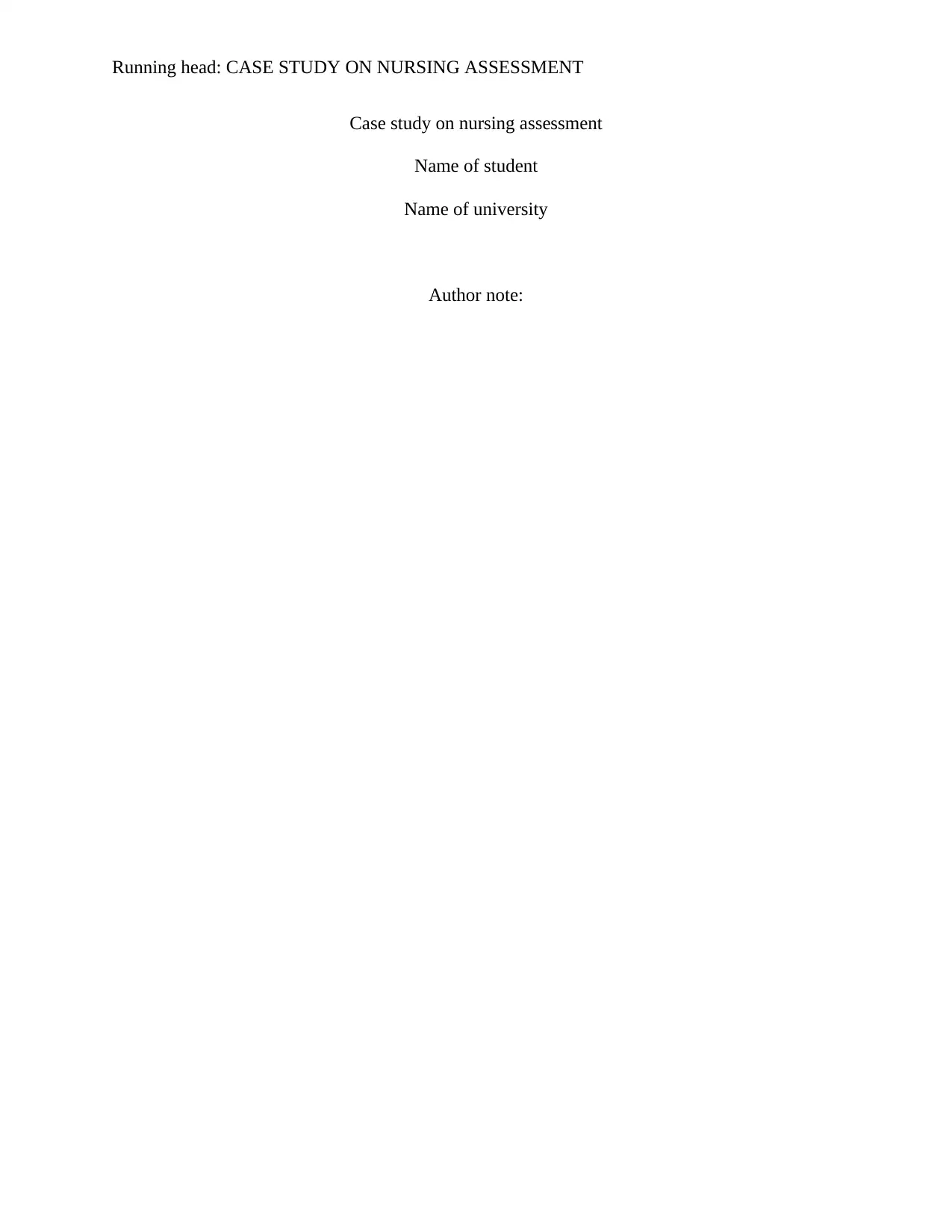
Running head: CASE STUDY ON NURSING ASSESSMENT
Case study on nursing assessment
Name of student
Name of university
Author note:
Case study on nursing assessment
Name of student
Name of university
Author note:
Secure Best Marks with AI Grader
Need help grading? Try our AI Grader for instant feedback on your assignments.
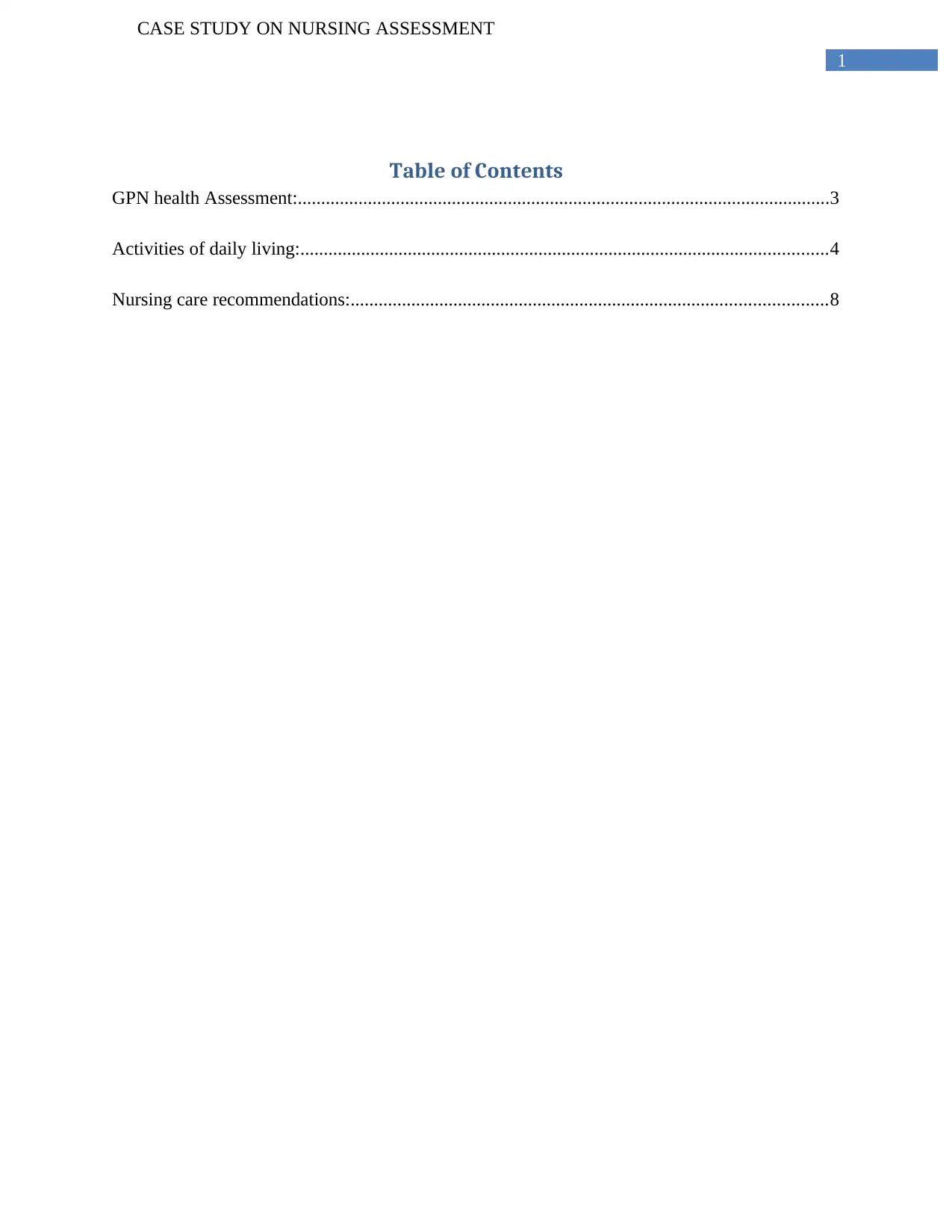
1
CASE STUDY ON NURSING ASSESSMENT
Table of Contents
GPN health Assessment:..................................................................................................................3
Activities of daily living:.................................................................................................................4
Nursing care recommendations:......................................................................................................8
CASE STUDY ON NURSING ASSESSMENT
Table of Contents
GPN health Assessment:..................................................................................................................3
Activities of daily living:.................................................................................................................4
Nursing care recommendations:......................................................................................................8
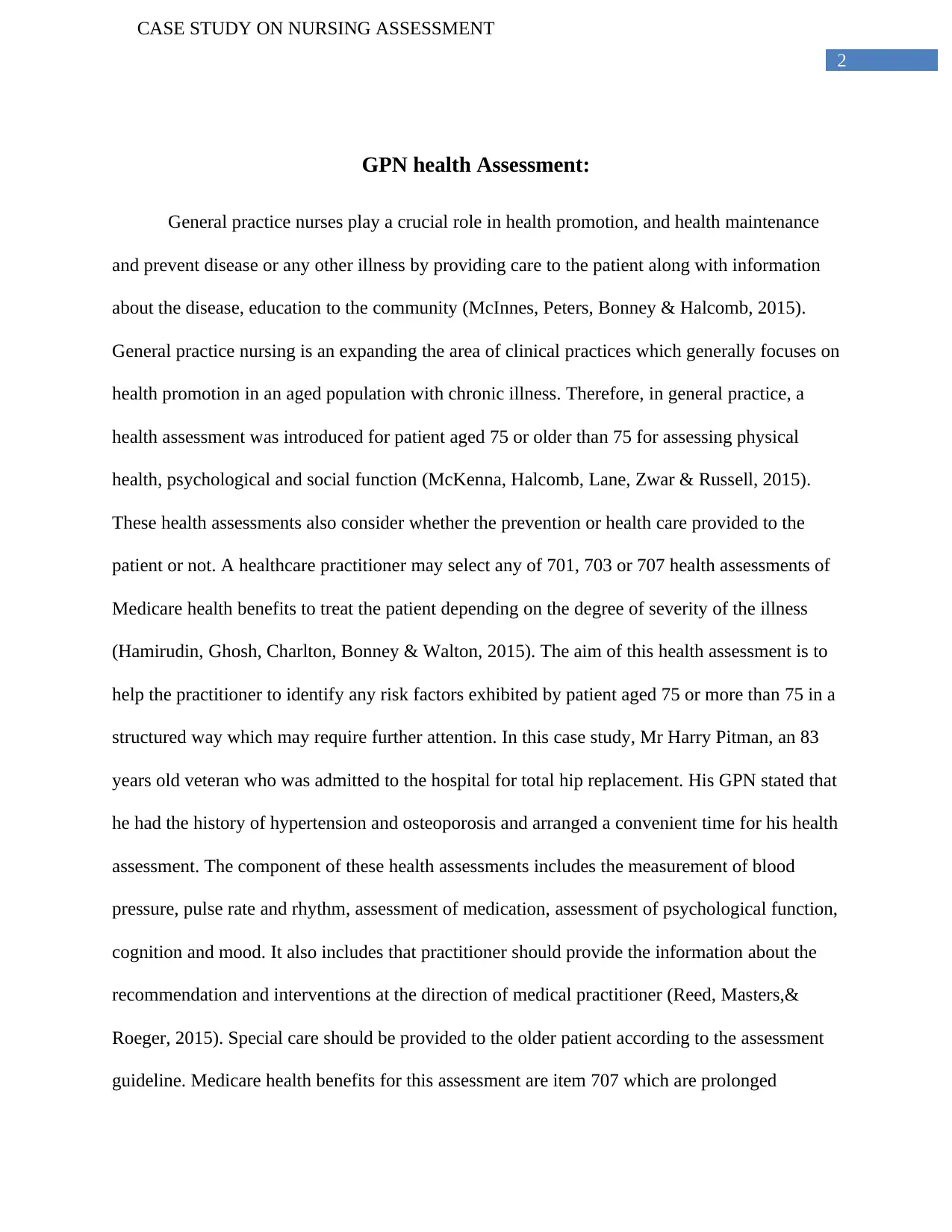
2
CASE STUDY ON NURSING ASSESSMENT
GPN health Assessment:
General practice nurses play a crucial role in health promotion, and health maintenance
and prevent disease or any other illness by providing care to the patient along with information
about the disease, education to the community (McInnes, Peters, Bonney & Halcomb, 2015).
General practice nursing is an expanding the area of clinical practices which generally focuses on
health promotion in an aged population with chronic illness. Therefore, in general practice, a
health assessment was introduced for patient aged 75 or older than 75 for assessing physical
health, psychological and social function (McKenna, Halcomb, Lane, Zwar & Russell, 2015).
These health assessments also consider whether the prevention or health care provided to the
patient or not. A healthcare practitioner may select any of 701, 703 or 707 health assessments of
Medicare health benefits to treat the patient depending on the degree of severity of the illness
(Hamirudin, Ghosh, Charlton, Bonney & Walton, 2015). The aim of this health assessment is to
help the practitioner to identify any risk factors exhibited by patient aged 75 or more than 75 in a
structured way which may require further attention. In this case study, Mr Harry Pitman, an 83
years old veteran who was admitted to the hospital for total hip replacement. His GPN stated that
he had the history of hypertension and osteoporosis and arranged a convenient time for his health
assessment. The component of these health assessments includes the measurement of blood
pressure, pulse rate and rhythm, assessment of medication, assessment of psychological function,
cognition and mood. It also includes that practitioner should provide the information about the
recommendation and interventions at the direction of medical practitioner (Reed, Masters,&
Roeger, 2015). Special care should be provided to the older patient according to the assessment
guideline. Medicare health benefits for this assessment are item 707 which are prolonged
CASE STUDY ON NURSING ASSESSMENT
GPN health Assessment:
General practice nurses play a crucial role in health promotion, and health maintenance
and prevent disease or any other illness by providing care to the patient along with information
about the disease, education to the community (McInnes, Peters, Bonney & Halcomb, 2015).
General practice nursing is an expanding the area of clinical practices which generally focuses on
health promotion in an aged population with chronic illness. Therefore, in general practice, a
health assessment was introduced for patient aged 75 or older than 75 for assessing physical
health, psychological and social function (McKenna, Halcomb, Lane, Zwar & Russell, 2015).
These health assessments also consider whether the prevention or health care provided to the
patient or not. A healthcare practitioner may select any of 701, 703 or 707 health assessments of
Medicare health benefits to treat the patient depending on the degree of severity of the illness
(Hamirudin, Ghosh, Charlton, Bonney & Walton, 2015). The aim of this health assessment is to
help the practitioner to identify any risk factors exhibited by patient aged 75 or more than 75 in a
structured way which may require further attention. In this case study, Mr Harry Pitman, an 83
years old veteran who was admitted to the hospital for total hip replacement. His GPN stated that
he had the history of hypertension and osteoporosis and arranged a convenient time for his health
assessment. The component of these health assessments includes the measurement of blood
pressure, pulse rate and rhythm, assessment of medication, assessment of psychological function,
cognition and mood. It also includes that practitioner should provide the information about the
recommendation and interventions at the direction of medical practitioner (Reed, Masters,&
Roeger, 2015). Special care should be provided to the older patient according to the assessment
guideline. Medicare health benefits for this assessment are item 707 which are prolonged
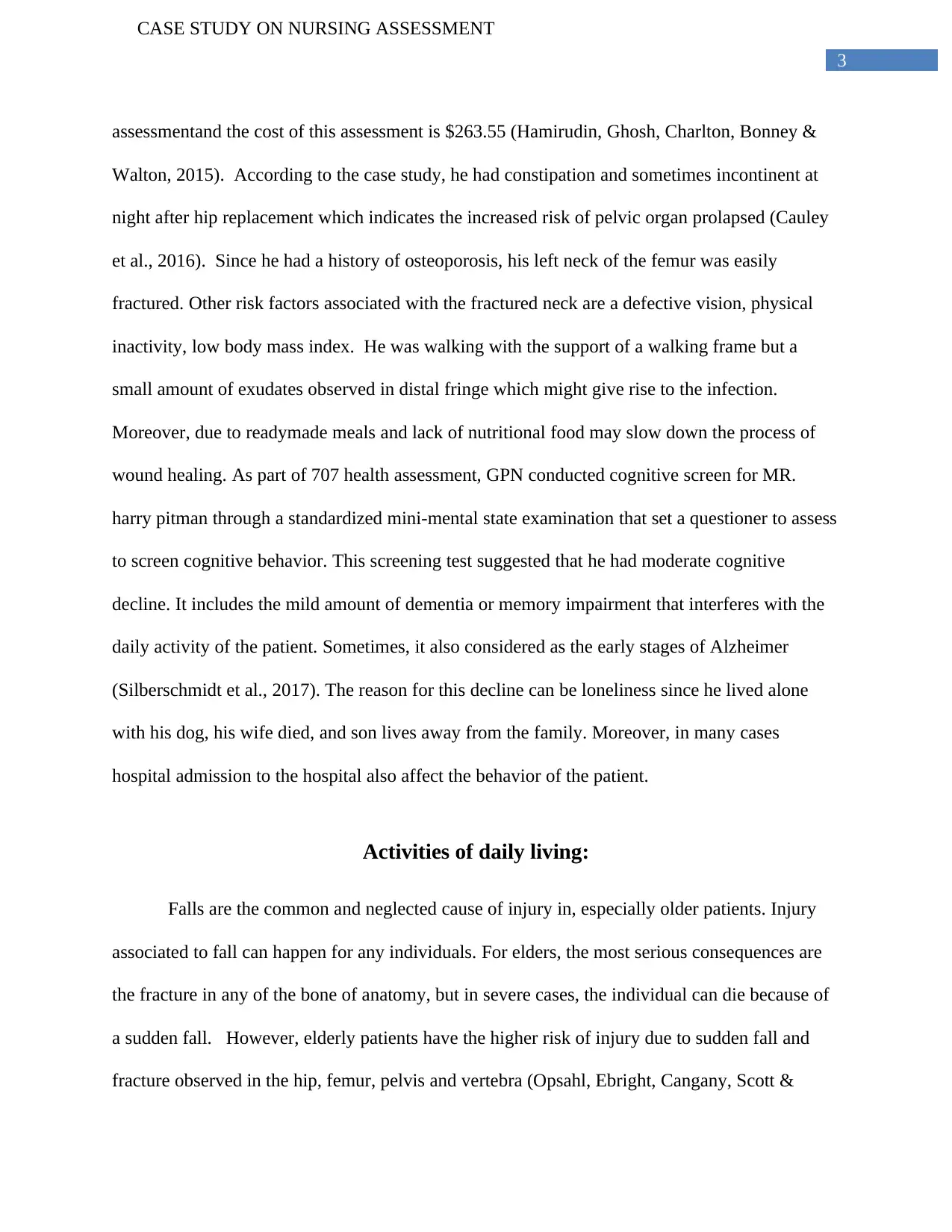
3
CASE STUDY ON NURSING ASSESSMENT
assessmentand the cost of this assessment is $263.55 (Hamirudin, Ghosh, Charlton, Bonney &
Walton, 2015). According to the case study, he had constipation and sometimes incontinent at
night after hip replacement which indicates the increased risk of pelvic organ prolapsed (Cauley
et al., 2016). Since he had a history of osteoporosis, his left neck of the femur was easily
fractured. Other risk factors associated with the fractured neck are a defective vision, physical
inactivity, low body mass index. He was walking with the support of a walking frame but a
small amount of exudates observed in distal fringe which might give rise to the infection.
Moreover, due to readymade meals and lack of nutritional food may slow down the process of
wound healing. As part of 707 health assessment, GPN conducted cognitive screen for MR.
harry pitman through a standardized mini-mental state examination that set a questioner to assess
to screen cognitive behavior. This screening test suggested that he had moderate cognitive
decline. It includes the mild amount of dementia or memory impairment that interferes with the
daily activity of the patient. Sometimes, it also considered as the early stages of Alzheimer
(Silberschmidt et al., 2017). The reason for this decline can be loneliness since he lived alone
with his dog, his wife died, and son lives away from the family. Moreover, in many cases
hospital admission to the hospital also affect the behavior of the patient.
Activities of daily living:
Falls are the common and neglected cause of injury in, especially older patients. Injury
associated to fall can happen for any individuals. For elders, the most serious consequences are
the fracture in any of the bone of anatomy, but in severe cases, the individual can die because of
a sudden fall. However, elderly patients have the higher risk of injury due to sudden fall and
fracture observed in the hip, femur, pelvis and vertebra (Opsahl, Ebright, Cangany, Scott &
CASE STUDY ON NURSING ASSESSMENT
assessmentand the cost of this assessment is $263.55 (Hamirudin, Ghosh, Charlton, Bonney &
Walton, 2015). According to the case study, he had constipation and sometimes incontinent at
night after hip replacement which indicates the increased risk of pelvic organ prolapsed (Cauley
et al., 2016). Since he had a history of osteoporosis, his left neck of the femur was easily
fractured. Other risk factors associated with the fractured neck are a defective vision, physical
inactivity, low body mass index. He was walking with the support of a walking frame but a
small amount of exudates observed in distal fringe which might give rise to the infection.
Moreover, due to readymade meals and lack of nutritional food may slow down the process of
wound healing. As part of 707 health assessment, GPN conducted cognitive screen for MR.
harry pitman through a standardized mini-mental state examination that set a questioner to assess
to screen cognitive behavior. This screening test suggested that he had moderate cognitive
decline. It includes the mild amount of dementia or memory impairment that interferes with the
daily activity of the patient. Sometimes, it also considered as the early stages of Alzheimer
(Silberschmidt et al., 2017). The reason for this decline can be loneliness since he lived alone
with his dog, his wife died, and son lives away from the family. Moreover, in many cases
hospital admission to the hospital also affect the behavior of the patient.
Activities of daily living:
Falls are the common and neglected cause of injury in, especially older patients. Injury
associated to fall can happen for any individuals. For elders, the most serious consequences are
the fracture in any of the bone of anatomy, but in severe cases, the individual can die because of
a sudden fall. However, elderly patients have the higher risk of injury due to sudden fall and
fracture observed in the hip, femur, pelvis and vertebra (Opsahl, Ebright, Cangany, Scott &
Secure Best Marks with AI Grader
Need help grading? Try our AI Grader for instant feedback on your assignments.
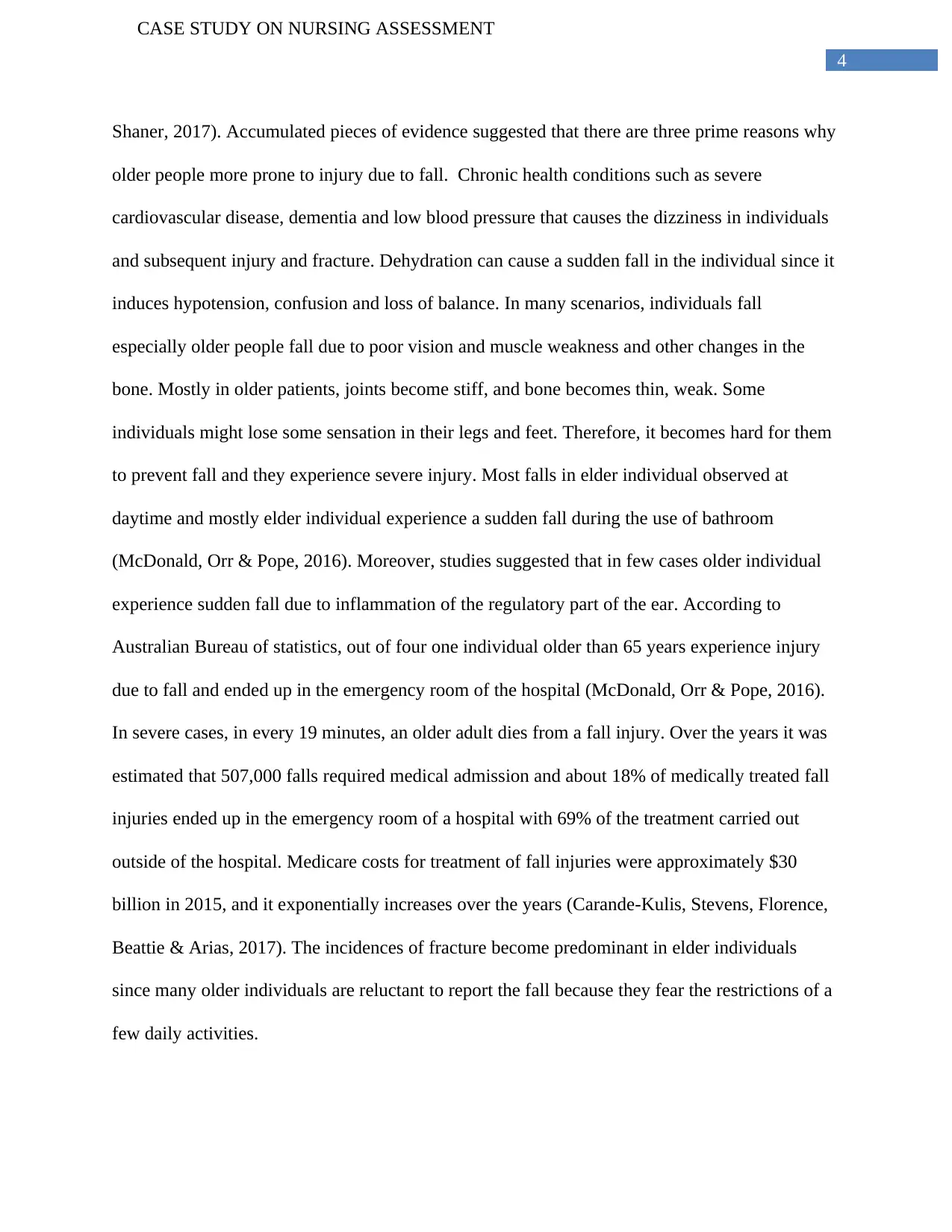
4
CASE STUDY ON NURSING ASSESSMENT
Shaner, 2017). Accumulated pieces of evidence suggested that there are three prime reasons why
older people more prone to injury due to fall. Chronic health conditions such as severe
cardiovascular disease, dementia and low blood pressure that causes the dizziness in individuals
and subsequent injury and fracture. Dehydration can cause a sudden fall in the individual since it
induces hypotension, confusion and loss of balance. In many scenarios, individuals fall
especially older people fall due to poor vision and muscle weakness and other changes in the
bone. Mostly in older patients, joints become stiff, and bone becomes thin, weak. Some
individuals might lose some sensation in their legs and feet. Therefore, it becomes hard for them
to prevent fall and they experience severe injury. Most falls in elder individual observed at
daytime and mostly elder individual experience a sudden fall during the use of bathroom
(McDonald, Orr & Pope, 2016). Moreover, studies suggested that in few cases older individual
experience sudden fall due to inflammation of the regulatory part of the ear. According to
Australian Bureau of statistics, out of four one individual older than 65 years experience injury
due to fall and ended up in the emergency room of the hospital (McDonald, Orr & Pope, 2016).
In severe cases, in every 19 minutes, an older adult dies from a fall injury. Over the years it was
estimated that 507,000 falls required medical admission and about 18% of medically treated fall
injuries ended up in the emergency room of a hospital with 69% of the treatment carried out
outside of the hospital. Medicare costs for treatment of fall injuries were approximately $30
billion in 2015, and it exponentially increases over the years (Carande-Kulis, Stevens, Florence,
Beattie & Arias, 2017). The incidences of fracture become predominant in elder individuals
since many older individuals are reluctant to report the fall because they fear the restrictions of a
few daily activities.
CASE STUDY ON NURSING ASSESSMENT
Shaner, 2017). Accumulated pieces of evidence suggested that there are three prime reasons why
older people more prone to injury due to fall. Chronic health conditions such as severe
cardiovascular disease, dementia and low blood pressure that causes the dizziness in individuals
and subsequent injury and fracture. Dehydration can cause a sudden fall in the individual since it
induces hypotension, confusion and loss of balance. In many scenarios, individuals fall
especially older people fall due to poor vision and muscle weakness and other changes in the
bone. Mostly in older patients, joints become stiff, and bone becomes thin, weak. Some
individuals might lose some sensation in their legs and feet. Therefore, it becomes hard for them
to prevent fall and they experience severe injury. Most falls in elder individual observed at
daytime and mostly elder individual experience a sudden fall during the use of bathroom
(McDonald, Orr & Pope, 2016). Moreover, studies suggested that in few cases older individual
experience sudden fall due to inflammation of the regulatory part of the ear. According to
Australian Bureau of statistics, out of four one individual older than 65 years experience injury
due to fall and ended up in the emergency room of the hospital (McDonald, Orr & Pope, 2016).
In severe cases, in every 19 minutes, an older adult dies from a fall injury. Over the years it was
estimated that 507,000 falls required medical admission and about 18% of medically treated fall
injuries ended up in the emergency room of a hospital with 69% of the treatment carried out
outside of the hospital. Medicare costs for treatment of fall injuries were approximately $30
billion in 2015, and it exponentially increases over the years (Carande-Kulis, Stevens, Florence,
Beattie & Arias, 2017). The incidences of fracture become predominant in elder individuals
since many older individuals are reluctant to report the fall because they fear the restrictions of a
few daily activities.
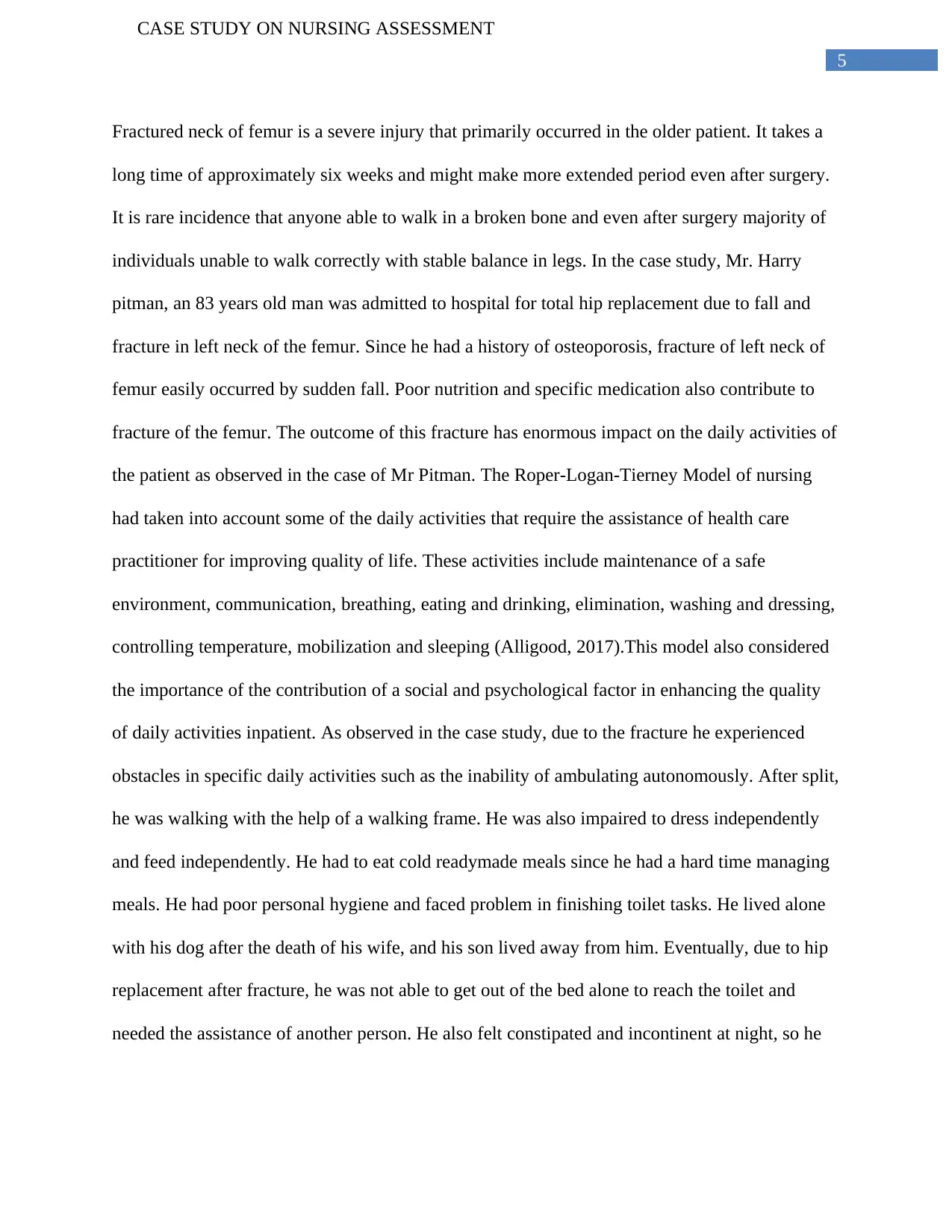
5
CASE STUDY ON NURSING ASSESSMENT
Fractured neck of femur is a severe injury that primarily occurred in the older patient. It takes a
long time of approximately six weeks and might make more extended period even after surgery.
It is rare incidence that anyone able to walk in a broken bone and even after surgery majority of
individuals unable to walk correctly with stable balance in legs. In the case study, Mr. Harry
pitman, an 83 years old man was admitted to hospital for total hip replacement due to fall and
fracture in left neck of the femur. Since he had a history of osteoporosis, fracture of left neck of
femur easily occurred by sudden fall. Poor nutrition and specific medication also contribute to
fracture of the femur. The outcome of this fracture has enormous impact on the daily activities of
the patient as observed in the case of Mr Pitman. The Roper-Logan-Tierney Model of nursing
had taken into account some of the daily activities that require the assistance of health care
practitioner for improving quality of life. These activities include maintenance of a safe
environment, communication, breathing, eating and drinking, elimination, washing and dressing,
controlling temperature, mobilization and sleeping (Alligood, 2017).This model also considered
the importance of the contribution of a social and psychological factor in enhancing the quality
of daily activities inpatient. As observed in the case study, due to the fracture he experienced
obstacles in specific daily activities such as the inability of ambulating autonomously. After split,
he was walking with the help of a walking frame. He was also impaired to dress independently
and feed independently. He had to eat cold readymade meals since he had a hard time managing
meals. He had poor personal hygiene and faced problem in finishing toilet tasks. He lived alone
with his dog after the death of his wife, and his son lived away from him. Eventually, due to hip
replacement after fracture, he was not able to get out of the bed alone to reach the toilet and
needed the assistance of another person. He also felt constipated and incontinent at night, so he
CASE STUDY ON NURSING ASSESSMENT
Fractured neck of femur is a severe injury that primarily occurred in the older patient. It takes a
long time of approximately six weeks and might make more extended period even after surgery.
It is rare incidence that anyone able to walk in a broken bone and even after surgery majority of
individuals unable to walk correctly with stable balance in legs. In the case study, Mr. Harry
pitman, an 83 years old man was admitted to hospital for total hip replacement due to fall and
fracture in left neck of the femur. Since he had a history of osteoporosis, fracture of left neck of
femur easily occurred by sudden fall. Poor nutrition and specific medication also contribute to
fracture of the femur. The outcome of this fracture has enormous impact on the daily activities of
the patient as observed in the case of Mr Pitman. The Roper-Logan-Tierney Model of nursing
had taken into account some of the daily activities that require the assistance of health care
practitioner for improving quality of life. These activities include maintenance of a safe
environment, communication, breathing, eating and drinking, elimination, washing and dressing,
controlling temperature, mobilization and sleeping (Alligood, 2017).This model also considered
the importance of the contribution of a social and psychological factor in enhancing the quality
of daily activities inpatient. As observed in the case study, due to the fracture he experienced
obstacles in specific daily activities such as the inability of ambulating autonomously. After split,
he was walking with the help of a walking frame. He was also impaired to dress independently
and feed independently. He had to eat cold readymade meals since he had a hard time managing
meals. He had poor personal hygiene and faced problem in finishing toilet tasks. He lived alone
with his dog after the death of his wife, and his son lived away from him. Eventually, due to hip
replacement after fracture, he was not able to get out of the bed alone to reach the toilet and
needed the assistance of another person. He also felt constipated and incontinent at night, so he
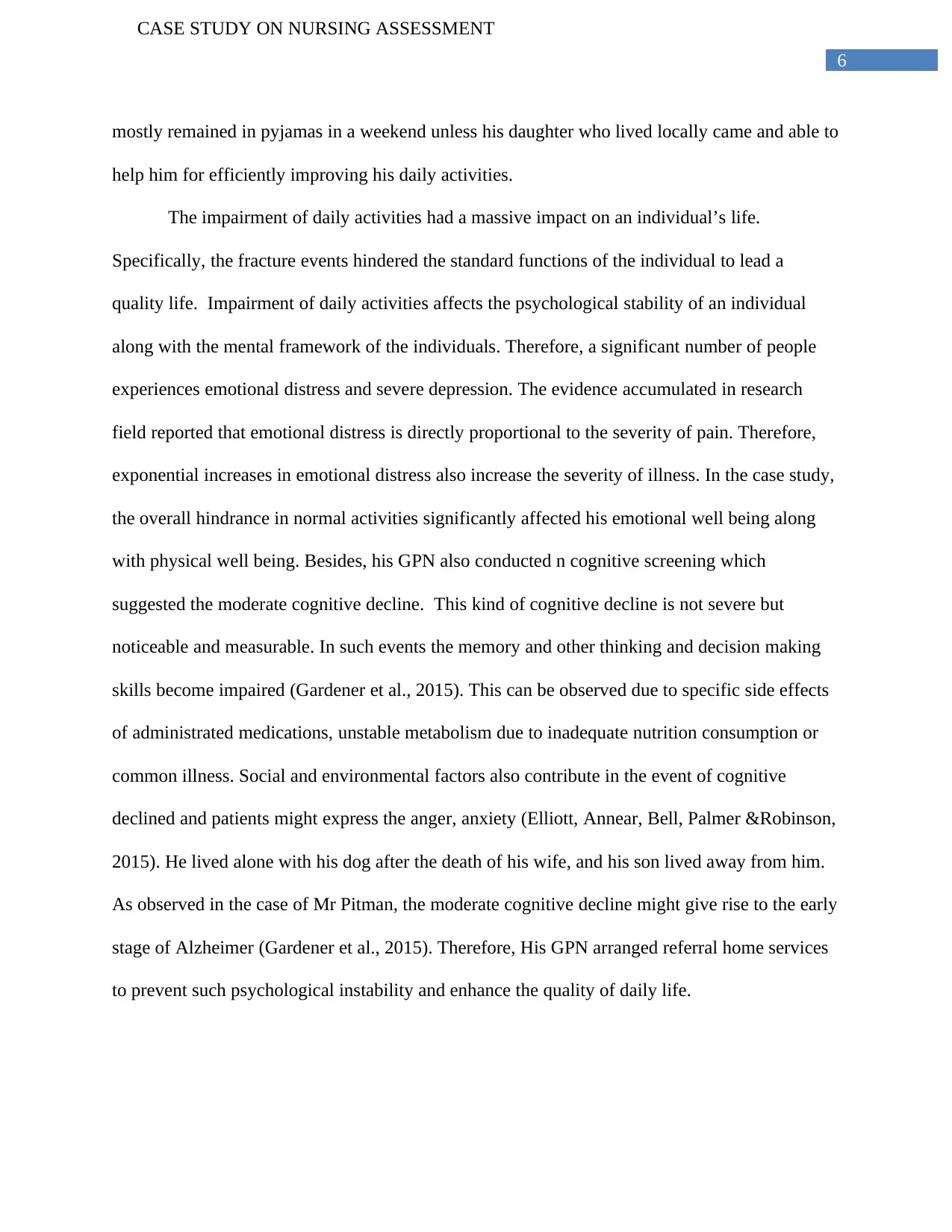
6
CASE STUDY ON NURSING ASSESSMENT
mostly remained in pyjamas in a weekend unless his daughter who lived locally came and able to
help him for efficiently improving his daily activities.
The impairment of daily activities had a massive impact on an individual’s life.
Specifically, the fracture events hindered the standard functions of the individual to lead a
quality life. Impairment of daily activities affects the psychological stability of an individual
along with the mental framework of the individuals. Therefore, a significant number of people
experiences emotional distress and severe depression. The evidence accumulated in research
field reported that emotional distress is directly proportional to the severity of pain. Therefore,
exponential increases in emotional distress also increase the severity of illness. In the case study,
the overall hindrance in normal activities significantly affected his emotional well being along
with physical well being. Besides, his GPN also conducted n cognitive screening which
suggested the moderate cognitive decline. This kind of cognitive decline is not severe but
noticeable and measurable. In such events the memory and other thinking and decision making
skills become impaired (Gardener et al., 2015). This can be observed due to specific side effects
of administrated medications, unstable metabolism due to inadequate nutrition consumption or
common illness. Social and environmental factors also contribute in the event of cognitive
declined and patients might express the anger, anxiety (Elliott, Annear, Bell, Palmer &Robinson,
2015). He lived alone with his dog after the death of his wife, and his son lived away from him.
As observed in the case of Mr Pitman, the moderate cognitive decline might give rise to the early
stage of Alzheimer (Gardener et al., 2015). Therefore, His GPN arranged referral home services
to prevent such psychological instability and enhance the quality of daily life.
CASE STUDY ON NURSING ASSESSMENT
mostly remained in pyjamas in a weekend unless his daughter who lived locally came and able to
help him for efficiently improving his daily activities.
The impairment of daily activities had a massive impact on an individual’s life.
Specifically, the fracture events hindered the standard functions of the individual to lead a
quality life. Impairment of daily activities affects the psychological stability of an individual
along with the mental framework of the individuals. Therefore, a significant number of people
experiences emotional distress and severe depression. The evidence accumulated in research
field reported that emotional distress is directly proportional to the severity of pain. Therefore,
exponential increases in emotional distress also increase the severity of illness. In the case study,
the overall hindrance in normal activities significantly affected his emotional well being along
with physical well being. Besides, his GPN also conducted n cognitive screening which
suggested the moderate cognitive decline. This kind of cognitive decline is not severe but
noticeable and measurable. In such events the memory and other thinking and decision making
skills become impaired (Gardener et al., 2015). This can be observed due to specific side effects
of administrated medications, unstable metabolism due to inadequate nutrition consumption or
common illness. Social and environmental factors also contribute in the event of cognitive
declined and patients might express the anger, anxiety (Elliott, Annear, Bell, Palmer &Robinson,
2015). He lived alone with his dog after the death of his wife, and his son lived away from him.
As observed in the case of Mr Pitman, the moderate cognitive decline might give rise to the early
stage of Alzheimer (Gardener et al., 2015). Therefore, His GPN arranged referral home services
to prevent such psychological instability and enhance the quality of daily life.
Paraphrase This Document
Need a fresh take? Get an instant paraphrase of this document with our AI Paraphraser
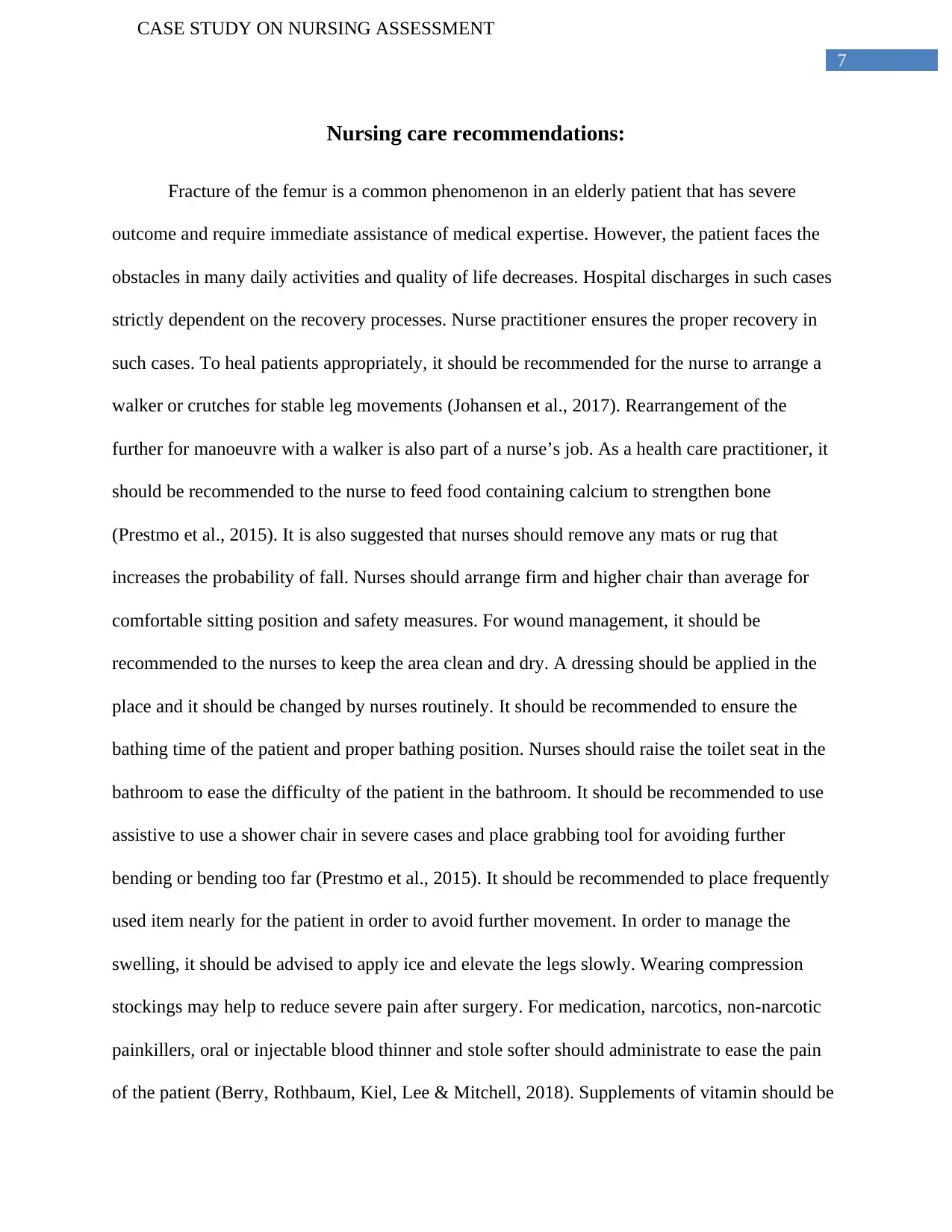
7
CASE STUDY ON NURSING ASSESSMENT
Nursing care recommendations:
Fracture of the femur is a common phenomenon in an elderly patient that has severe
outcome and require immediate assistance of medical expertise. However, the patient faces the
obstacles in many daily activities and quality of life decreases. Hospital discharges in such cases
strictly dependent on the recovery processes. Nurse practitioner ensures the proper recovery in
such cases. To heal patients appropriately, it should be recommended for the nurse to arrange a
walker or crutches for stable leg movements (Johansen et al., 2017). Rearrangement of the
further for manoeuvre with a walker is also part of a nurse’s job. As a health care practitioner, it
should be recommended to the nurse to feed food containing calcium to strengthen bone
(Prestmo et al., 2015). It is also suggested that nurses should remove any mats or rug that
increases the probability of fall. Nurses should arrange firm and higher chair than average for
comfortable sitting position and safety measures. For wound management, it should be
recommended to the nurses to keep the area clean and dry. A dressing should be applied in the
place and it should be changed by nurses routinely. It should be recommended to ensure the
bathing time of the patient and proper bathing position. Nurses should raise the toilet seat in the
bathroom to ease the difficulty of the patient in the bathroom. It should be recommended to use
assistive to use a shower chair in severe cases and place grabbing tool for avoiding further
bending or bending too far (Prestmo et al., 2015). It should be recommended to place frequently
used item nearly for the patient in order to avoid further movement. In order to manage the
swelling, it should be advised to apply ice and elevate the legs slowly. Wearing compression
stockings may help to reduce severe pain after surgery. For medication, narcotics, non-narcotic
painkillers, oral or injectable blood thinner and stole softer should administrate to ease the pain
of the patient (Berry, Rothbaum, Kiel, Lee & Mitchell, 2018). Supplements of vitamin should be
CASE STUDY ON NURSING ASSESSMENT
Nursing care recommendations:
Fracture of the femur is a common phenomenon in an elderly patient that has severe
outcome and require immediate assistance of medical expertise. However, the patient faces the
obstacles in many daily activities and quality of life decreases. Hospital discharges in such cases
strictly dependent on the recovery processes. Nurse practitioner ensures the proper recovery in
such cases. To heal patients appropriately, it should be recommended for the nurse to arrange a
walker or crutches for stable leg movements (Johansen et al., 2017). Rearrangement of the
further for manoeuvre with a walker is also part of a nurse’s job. As a health care practitioner, it
should be recommended to the nurse to feed food containing calcium to strengthen bone
(Prestmo et al., 2015). It is also suggested that nurses should remove any mats or rug that
increases the probability of fall. Nurses should arrange firm and higher chair than average for
comfortable sitting position and safety measures. For wound management, it should be
recommended to the nurses to keep the area clean and dry. A dressing should be applied in the
place and it should be changed by nurses routinely. It should be recommended to ensure the
bathing time of the patient and proper bathing position. Nurses should raise the toilet seat in the
bathroom to ease the difficulty of the patient in the bathroom. It should be recommended to use
assistive to use a shower chair in severe cases and place grabbing tool for avoiding further
bending or bending too far (Prestmo et al., 2015). It should be recommended to place frequently
used item nearly for the patient in order to avoid further movement. In order to manage the
swelling, it should be advised to apply ice and elevate the legs slowly. Wearing compression
stockings may help to reduce severe pain after surgery. For medication, narcotics, non-narcotic
painkillers, oral or injectable blood thinner and stole softer should administrate to ease the pain
of the patient (Berry, Rothbaum, Kiel, Lee & Mitchell, 2018). Supplements of vitamin should be
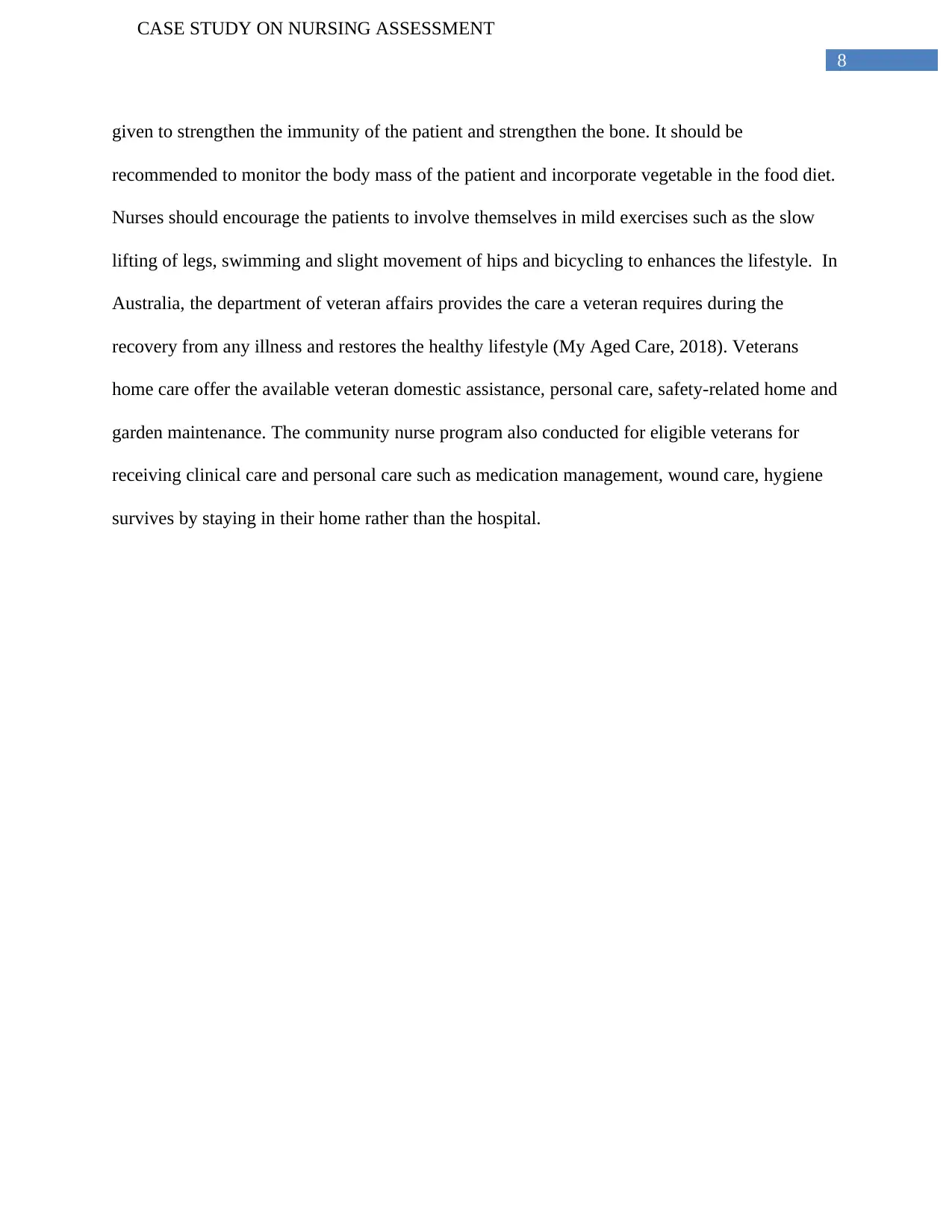
8
CASE STUDY ON NURSING ASSESSMENT
given to strengthen the immunity of the patient and strengthen the bone. It should be
recommended to monitor the body mass of the patient and incorporate vegetable in the food diet.
Nurses should encourage the patients to involve themselves in mild exercises such as the slow
lifting of legs, swimming and slight movement of hips and bicycling to enhances the lifestyle. In
Australia, the department of veteran affairs provides the care a veteran requires during the
recovery from any illness and restores the healthy lifestyle (My Aged Care, 2018). Veterans
home care offer the available veteran domestic assistance, personal care, safety-related home and
garden maintenance. The community nurse program also conducted for eligible veterans for
receiving clinical care and personal care such as medication management, wound care, hygiene
survives by staying in their home rather than the hospital.
CASE STUDY ON NURSING ASSESSMENT
given to strengthen the immunity of the patient and strengthen the bone. It should be
recommended to monitor the body mass of the patient and incorporate vegetable in the food diet.
Nurses should encourage the patients to involve themselves in mild exercises such as the slow
lifting of legs, swimming and slight movement of hips and bicycling to enhances the lifestyle. In
Australia, the department of veteran affairs provides the care a veteran requires during the
recovery from any illness and restores the healthy lifestyle (My Aged Care, 2018). Veterans
home care offer the available veteran domestic assistance, personal care, safety-related home and
garden maintenance. The community nurse program also conducted for eligible veterans for
receiving clinical care and personal care such as medication management, wound care, hygiene
survives by staying in their home rather than the hospital.
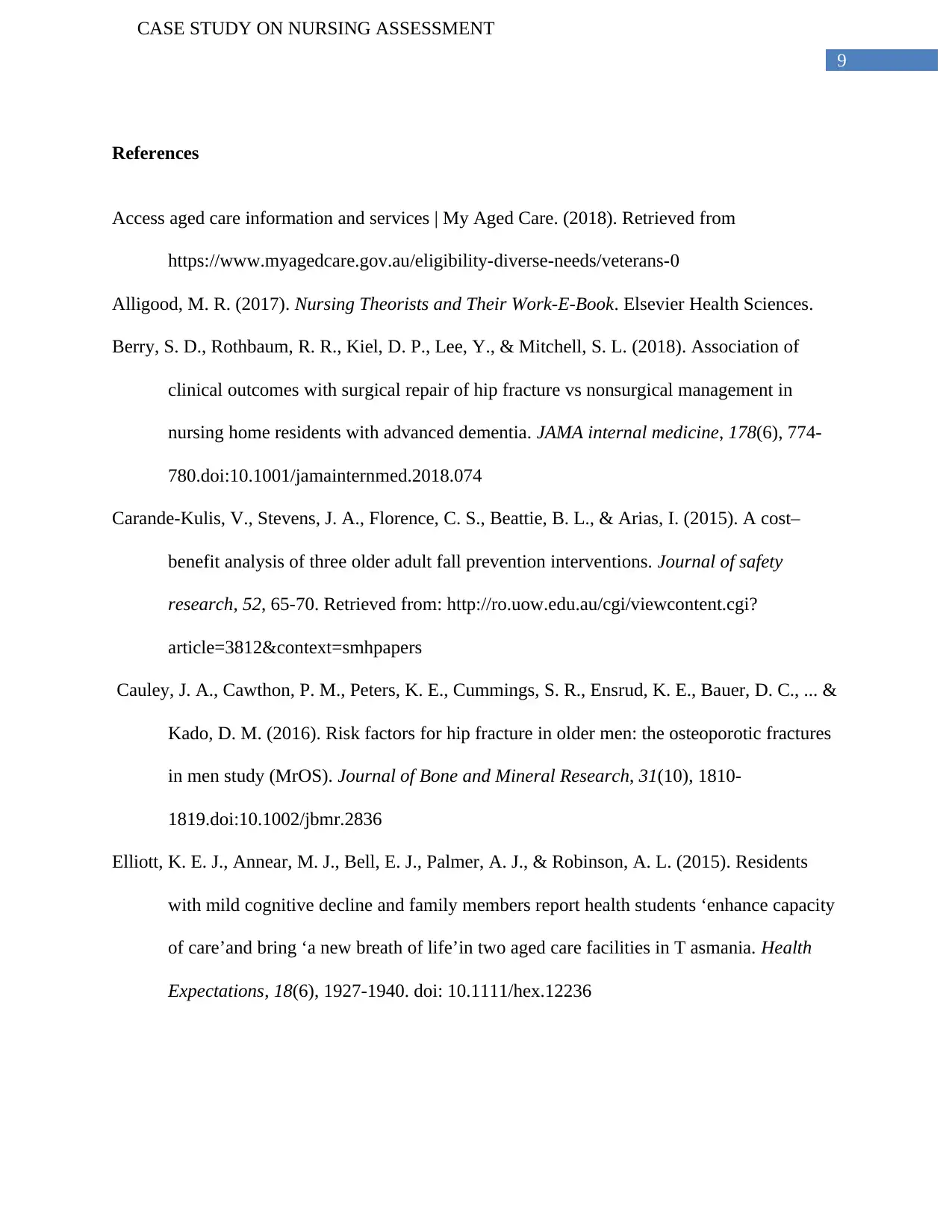
9
CASE STUDY ON NURSING ASSESSMENT
References
Access aged care information and services | My Aged Care. (2018). Retrieved from
https://www.myagedcare.gov.au/eligibility-diverse-needs/veterans-0
Alligood, M. R. (2017). Nursing Theorists and Their Work-E-Book. Elsevier Health Sciences.
Berry, S. D., Rothbaum, R. R., Kiel, D. P., Lee, Y., & Mitchell, S. L. (2018). Association of
clinical outcomes with surgical repair of hip fracture vs nonsurgical management in
nursing home residents with advanced dementia. JAMA internal medicine, 178(6), 774-
780.doi:10.1001/jamainternmed.2018.074
Carande-Kulis, V., Stevens, J. A., Florence, C. S., Beattie, B. L., & Arias, I. (2015). A cost–
benefit analysis of three older adult fall prevention interventions. Journal of safety
research, 52, 65-70. Retrieved from: http://ro.uow.edu.au/cgi/viewcontent.cgi?
article=3812&context=smhpapers
Cauley, J. A., Cawthon, P. M., Peters, K. E., Cummings, S. R., Ensrud, K. E., Bauer, D. C., ... &
Kado, D. M. (2016). Risk factors for hip fracture in older men: the osteoporotic fractures
in men study (MrOS). Journal of Bone and Mineral Research, 31(10), 1810-
1819.doi:10.1002/jbmr.2836
Elliott, K. E. J., Annear, M. J., Bell, E. J., Palmer, A. J., & Robinson, A. L. (2015). Residents
with mild cognitive decline and family members report health students ‘enhance capacity
of care’and bring ‘a new breath of life’in two aged care facilities in T asmania. Health
Expectations, 18(6), 1927-1940. doi: 10.1111/hex.12236
CASE STUDY ON NURSING ASSESSMENT
References
Access aged care information and services | My Aged Care. (2018). Retrieved from
https://www.myagedcare.gov.au/eligibility-diverse-needs/veterans-0
Alligood, M. R. (2017). Nursing Theorists and Their Work-E-Book. Elsevier Health Sciences.
Berry, S. D., Rothbaum, R. R., Kiel, D. P., Lee, Y., & Mitchell, S. L. (2018). Association of
clinical outcomes with surgical repair of hip fracture vs nonsurgical management in
nursing home residents with advanced dementia. JAMA internal medicine, 178(6), 774-
780.doi:10.1001/jamainternmed.2018.074
Carande-Kulis, V., Stevens, J. A., Florence, C. S., Beattie, B. L., & Arias, I. (2015). A cost–
benefit analysis of three older adult fall prevention interventions. Journal of safety
research, 52, 65-70. Retrieved from: http://ro.uow.edu.au/cgi/viewcontent.cgi?
article=3812&context=smhpapers
Cauley, J. A., Cawthon, P. M., Peters, K. E., Cummings, S. R., Ensrud, K. E., Bauer, D. C., ... &
Kado, D. M. (2016). Risk factors for hip fracture in older men: the osteoporotic fractures
in men study (MrOS). Journal of Bone and Mineral Research, 31(10), 1810-
1819.doi:10.1002/jbmr.2836
Elliott, K. E. J., Annear, M. J., Bell, E. J., Palmer, A. J., & Robinson, A. L. (2015). Residents
with mild cognitive decline and family members report health students ‘enhance capacity
of care’and bring ‘a new breath of life’in two aged care facilities in T asmania. Health
Expectations, 18(6), 1927-1940. doi: 10.1111/hex.12236
Secure Best Marks with AI Grader
Need help grading? Try our AI Grader for instant feedback on your assignments.
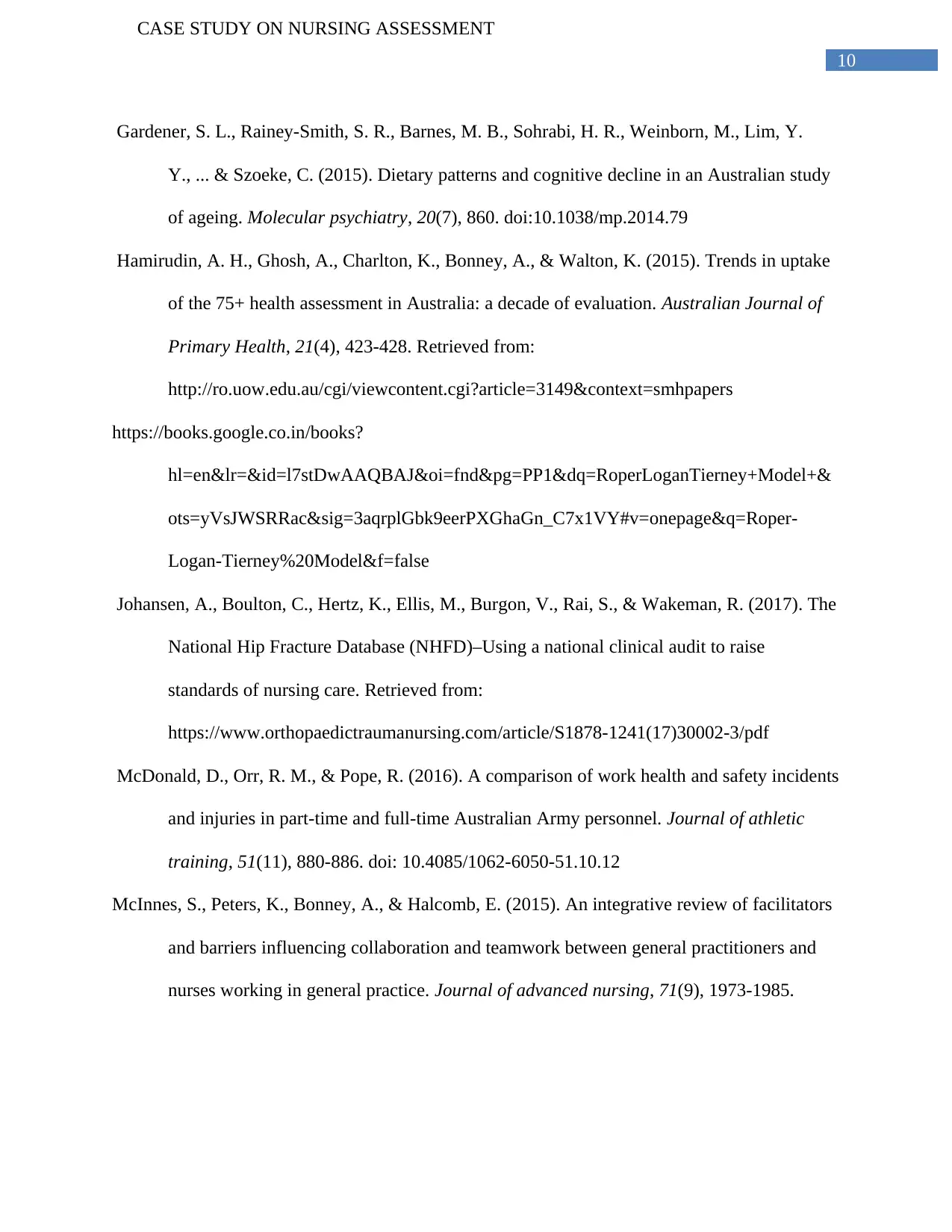
10
CASE STUDY ON NURSING ASSESSMENT
Gardener, S. L., Rainey-Smith, S. R., Barnes, M. B., Sohrabi, H. R., Weinborn, M., Lim, Y.
Y., ... & Szoeke, C. (2015). Dietary patterns and cognitive decline in an Australian study
of ageing. Molecular psychiatry, 20(7), 860. doi:10.1038/mp.2014.79
Hamirudin, A. H., Ghosh, A., Charlton, K., Bonney, A., & Walton, K. (2015). Trends in uptake
of the 75+ health assessment in Australia: a decade of evaluation. Australian Journal of
Primary Health, 21(4), 423-428. Retrieved from:
http://ro.uow.edu.au/cgi/viewcontent.cgi?article=3149&context=smhpapers
https://books.google.co.in/books?
hl=en&lr=&id=l7stDwAAQBAJ&oi=fnd&pg=PP1&dq=RoperLoganTierney+Model+&
ots=yVsJWSRRac&sig=3aqrplGbk9eerPXGhaGn_C7x1VY#v=onepage&q=Roper-
Logan-Tierney%20Model&f=false
Johansen, A., Boulton, C., Hertz, K., Ellis, M., Burgon, V., Rai, S., & Wakeman, R. (2017). The
National Hip Fracture Database (NHFD)–Using a national clinical audit to raise
standards of nursing care. Retrieved from:
https://www.orthopaedictraumanursing.com/article/S1878-1241(17)30002-3/pdf
McDonald, D., Orr, R. M., & Pope, R. (2016). A comparison of work health and safety incidents
and injuries in part-time and full-time Australian Army personnel. Journal of athletic
training, 51(11), 880-886. doi: 10.4085/1062-6050-51.10.12
McInnes, S., Peters, K., Bonney, A., & Halcomb, E. (2015). An integrative review of facilitators
and barriers influencing collaboration and teamwork between general practitioners and
nurses working in general practice. Journal of advanced nursing, 71(9), 1973-1985.
CASE STUDY ON NURSING ASSESSMENT
Gardener, S. L., Rainey-Smith, S. R., Barnes, M. B., Sohrabi, H. R., Weinborn, M., Lim, Y.
Y., ... & Szoeke, C. (2015). Dietary patterns and cognitive decline in an Australian study
of ageing. Molecular psychiatry, 20(7), 860. doi:10.1038/mp.2014.79
Hamirudin, A. H., Ghosh, A., Charlton, K., Bonney, A., & Walton, K. (2015). Trends in uptake
of the 75+ health assessment in Australia: a decade of evaluation. Australian Journal of
Primary Health, 21(4), 423-428. Retrieved from:
http://ro.uow.edu.au/cgi/viewcontent.cgi?article=3149&context=smhpapers
https://books.google.co.in/books?
hl=en&lr=&id=l7stDwAAQBAJ&oi=fnd&pg=PP1&dq=RoperLoganTierney+Model+&
ots=yVsJWSRRac&sig=3aqrplGbk9eerPXGhaGn_C7x1VY#v=onepage&q=Roper-
Logan-Tierney%20Model&f=false
Johansen, A., Boulton, C., Hertz, K., Ellis, M., Burgon, V., Rai, S., & Wakeman, R. (2017). The
National Hip Fracture Database (NHFD)–Using a national clinical audit to raise
standards of nursing care. Retrieved from:
https://www.orthopaedictraumanursing.com/article/S1878-1241(17)30002-3/pdf
McDonald, D., Orr, R. M., & Pope, R. (2016). A comparison of work health and safety incidents
and injuries in part-time and full-time Australian Army personnel. Journal of athletic
training, 51(11), 880-886. doi: 10.4085/1062-6050-51.10.12
McInnes, S., Peters, K., Bonney, A., & Halcomb, E. (2015). An integrative review of facilitators
and barriers influencing collaboration and teamwork between general practitioners and
nurses working in general practice. Journal of advanced nursing, 71(9), 1973-1985.
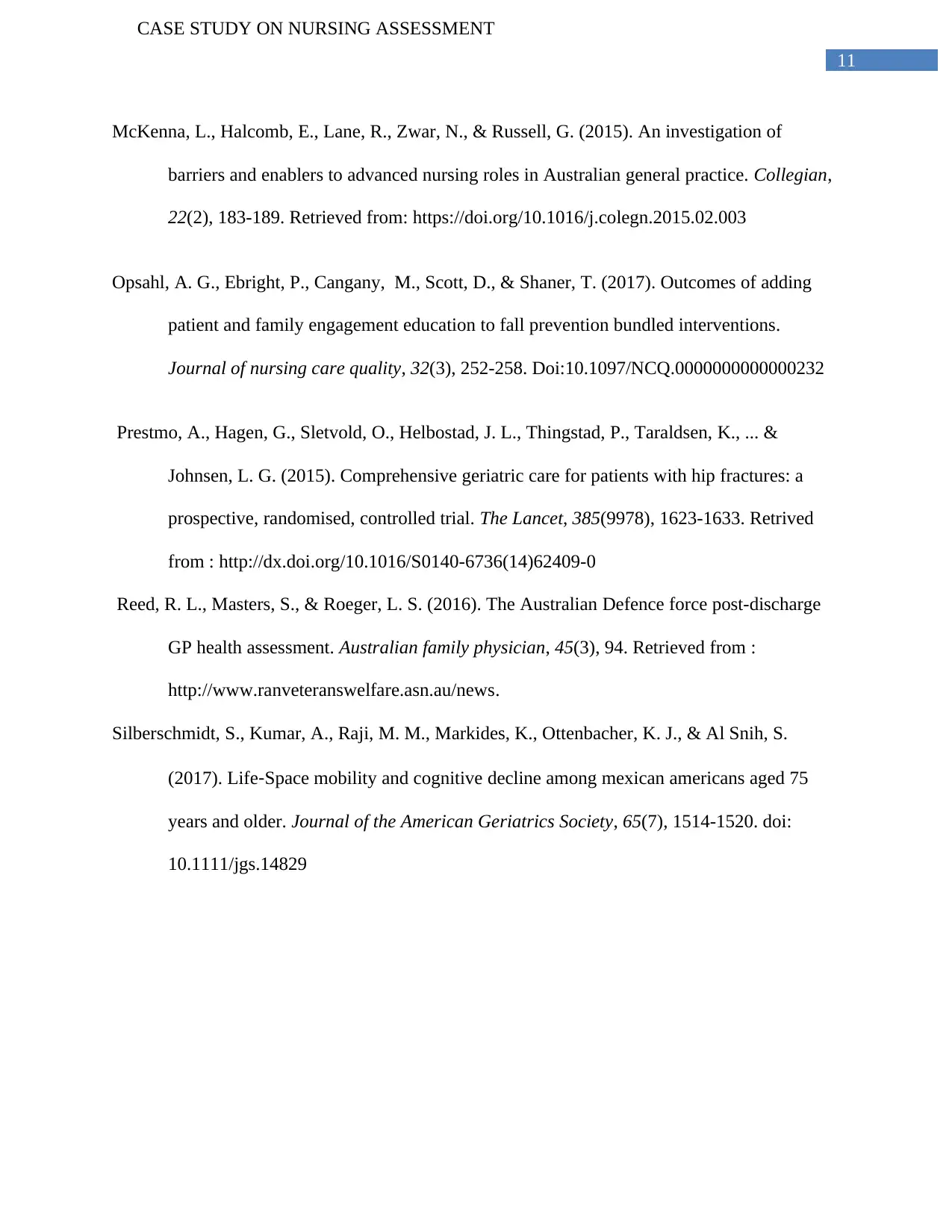
11
CASE STUDY ON NURSING ASSESSMENT
McKenna, L., Halcomb, E., Lane, R., Zwar, N., & Russell, G. (2015). An investigation of
barriers and enablers to advanced nursing roles in Australian general practice. Collegian,
22(2), 183-189. Retrieved from: https://doi.org/10.1016/j.colegn.2015.02.003
Opsahl, A. G., Ebright, P., Cangany, M., Scott, D., & Shaner, T. (2017). Outcomes of adding
patient and family engagement education to fall prevention bundled interventions.
Journal of nursing care quality, 32(3), 252-258. Doi:10.1097/NCQ.0000000000000232
Prestmo, A., Hagen, G., Sletvold, O., Helbostad, J. L., Thingstad, P., Taraldsen, K., ... &
Johnsen, L. G. (2015). Comprehensive geriatric care for patients with hip fractures: a
prospective, randomised, controlled trial. The Lancet, 385(9978), 1623-1633. Retrived
from : http://dx.doi.org/10.1016/S0140-6736(14)62409-0
Reed, R. L., Masters, S., & Roeger, L. S. (2016). The Australian Defence force post-discharge
GP health assessment. Australian family physician, 45(3), 94. Retrieved from :
http://www.ranveteranswelfare.asn.au/news.
Silberschmidt, S., Kumar, A., Raji, M. M., Markides, K., Ottenbacher, K. J., & Al Snih, S.
(2017). Life‐Space mobility and cognitive decline among mexican americans aged 75
years and older. Journal of the American Geriatrics Society, 65(7), 1514-1520. doi:
10.1111/jgs.14829
CASE STUDY ON NURSING ASSESSMENT
McKenna, L., Halcomb, E., Lane, R., Zwar, N., & Russell, G. (2015). An investigation of
barriers and enablers to advanced nursing roles in Australian general practice. Collegian,
22(2), 183-189. Retrieved from: https://doi.org/10.1016/j.colegn.2015.02.003
Opsahl, A. G., Ebright, P., Cangany, M., Scott, D., & Shaner, T. (2017). Outcomes of adding
patient and family engagement education to fall prevention bundled interventions.
Journal of nursing care quality, 32(3), 252-258. Doi:10.1097/NCQ.0000000000000232
Prestmo, A., Hagen, G., Sletvold, O., Helbostad, J. L., Thingstad, P., Taraldsen, K., ... &
Johnsen, L. G. (2015). Comprehensive geriatric care for patients with hip fractures: a
prospective, randomised, controlled trial. The Lancet, 385(9978), 1623-1633. Retrived
from : http://dx.doi.org/10.1016/S0140-6736(14)62409-0
Reed, R. L., Masters, S., & Roeger, L. S. (2016). The Australian Defence force post-discharge
GP health assessment. Australian family physician, 45(3), 94. Retrieved from :
http://www.ranveteranswelfare.asn.au/news.
Silberschmidt, S., Kumar, A., Raji, M. M., Markides, K., Ottenbacher, K. J., & Al Snih, S.
(2017). Life‐Space mobility and cognitive decline among mexican americans aged 75
years and older. Journal of the American Geriatrics Society, 65(7), 1514-1520. doi:
10.1111/jgs.14829
1 out of 12
Your All-in-One AI-Powered Toolkit for Academic Success.
+13062052269
info@desklib.com
Available 24*7 on WhatsApp / Email
![[object Object]](/_next/static/media/star-bottom.7253800d.svg)
Unlock your academic potential
© 2024 | Zucol Services PVT LTD | All rights reserved.

